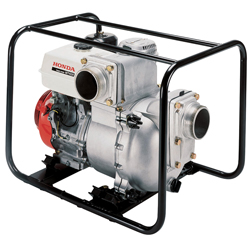 What kind of garbage can you safely move through a trash pump? How do you get the hoses set up to get the highest flow rate? Whether you’re a new owner of Honda’s WT40x trash pump or you’ve used one for years, these tips will help you set it up to work effectively and reliably.
What kind of garbage can you safely move through a trash pump? How do you get the hoses set up to get the highest flow rate? Whether you’re a new owner of Honda’s WT40x trash pump or you’ve used one for years, these tips will help you set it up to work effectively and reliably.Pre-Use Checks
Before you put your pump to work, there are a few things you should look at to make sure it’s ready to use.
— Look around for puddles from leaking fuel and oil before moving the pump.
— Check the oil level and condition of the air filter.
— Check the tightness of all bolts on the frame, pump, and engine.
— Make sure there’s fresh gas in the fuel tank. The pump should be able to run continuously for around 90 minutes with a full tank of gas.
Connecting the Hoses
Both the suction and discharge ports are designed to work with hoses that are four inches in diameter. The suction hose needs to have a built-in non-collapsible support layer or a braided wire layer to keep it open under negative pressure.
Some hoses have a coupler built into the end, while others need a coupler secured to the hose using a clamp. Use a sealing washer between the suction port and the coupler. This seal should be checked before each use as even a small leak can have a serious impact on performance.
This trash pump can handle solids up to 1 1/6 inch in diameter, but it still needs a strainer secured to the end of the suction hose to prevent larger objects from getting jammed in the impeller. If you need to completely drain a body of water, use a skimmer strainer. Its flat, conical shape keeps the openings submerged for as long as possible to prevent starvation.
Head and Pump Placement
This model has a total head of 82 feet and a maximum suction head of 26 feet. This is the maximum vertical distance that the pump can move water. The suction head is limited by the air pressure pushing down on the water. Expect it to decrease by about one foot for every 500 feet of elevation.
The impeller is better at pushing water than pulling. To get the highest possible pumping rate, try to use the shortest suction head possible, making up the difference with the discharge hose. Friction between the water and the hose also decreases pump performance. Using shorter hoses will help the pump move water faster.
Priming
The pump needs to be primed with water before starting. Remove the cap on the top of the pump housing and pour in four gallons of clean water.
If you skip this step, the pump will overheat, damaging the seals. If you start the engine after forgetting this step, shut it down immediately. Try again once the pump has had some time to cool down.
Starting and Stopping
The choke and fuel valve levers are located directly below the engine’s air cleaner box. Above and to the right of these controls, there’s a third lever that controls the throttle. The engine also has an ignition switch on the starter cover. To start the engine, do the following:
- Open the fuel valve.
- Set the choke. It can be left open if you’re restarting the engine, but otherwise, it should be pushed closed.
- Set the throttle to about 1/3 of the way from the “Slow” position.
- Turn on the ignition switch.
- Pull the starter grip.
Let the engine warm up, gradually opening the choke. Once the engine runs smoothly with the choke open, you can use the throttle to set the pumping speed. Keep in mind that it can take two or three minutes for water to be pumped from the strainer all the way to the end of the discharge hose.
The pump can be shut off immediately using the ignition switch, but it’s easier on the pump if you first move the throttle to the “Slow” position and wait for the engine to return to idle.
When You Need Parts, Go to Honda Lawn Parts
We may have “lawn” in our name, but we offer parts for everything from Honda’s power equipment and small engine lines. That includes strainers, hoses and replacement parts for the WT40 and the GX390 that powers it. We can ship these parts and accessories to any address in the US. or Canada. To order, visit www.hondalawnparts.com.
